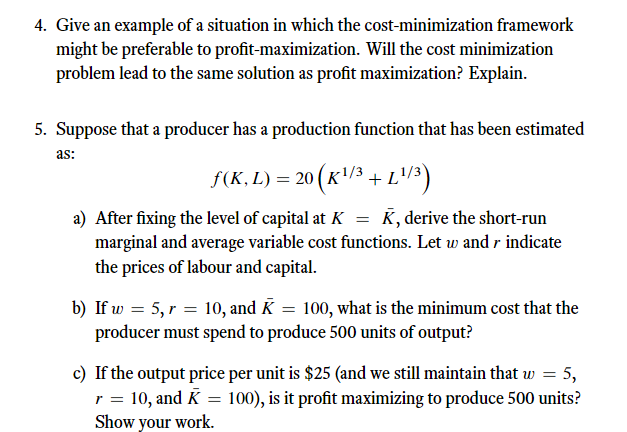Home /
Expert Answers /
Advanced Physics /
1-consider-a-production-function-for-alfalfa-given-by-f-k-l-a-ln-k-b-ln-l-where-pa506
(Solved): 1. Consider a production function for alfalfa, given by: \[ f(K, L)=a \ln (K)+b \ln (L), \] where ...
1. Consider a production function for alfalfa, given by: \[ f(K, L)=a \ln (K)+b \ln (L), \] where \( K \) and \( L \) denote capital and labour, \( a \) and \( b \) are parameters, and \( \ln \) is the natural \( \log \) function. a) With \( L \) fixed at \( \bar{L} \), set up the short-run profit maximization problem for choosing \( K \) to maximize profit. Use \( p \), w, and \( r \) to denote the prices of alfalfa, labour, and capital. b) Derive and interpret the first-order condition. Is the choice of \( K \) a function of \( \bar{L} \) ? Explain. c) Solve for the capital input demand function. d) Solve for the supply function. Does the fixed level of labour influence the supply function? Explain. e) Solve for the slope of the supply curve. Is it upward sloping? How do you know? 2. Explain and interpret the following condition from the long-run profit maximization problem: \[ \frac{\frac{\partial f(K, L)}{\partial K}}{r}=\frac{\frac{\partial f(K, L)}{\partial L}}{w} \] 3. Imagine that a grower uses two variable inputs to produce barley: nitrogen and labour. Use a graph with an isoquant and isocost lines to demonstrate how an increase in the price of nitrogen will influence the cost-minimizing choices of nitrogen and labour to produce a fixed amount of barley (say \( q_{0} \).) What characteristics of the production function will determine the extent to which the amounts of nitrogen and labour change?
4. Give an example of a situation in which the cost-minimization framework might be preferable to profit-maximization. Will the cost minimization problem lead to the same solution as profit maximization? Explain. 5. Suppose that a producer has a production function that has been estimated as: \[ f(K, L)=20\left(K^{1 / 3}+L^{1 / 3}\right) \] a) After fixing the level of capital at \( K=\bar{K} \), derive the short-run marginal and average variable cost functions. Let \( w \) and \( r \) indicate the prices of labour and capital. b) If \( w=5, r=10 \), and \( \bar{K}=100 \), what is the minimum cost that the producer must spend to produce 500 units of output? c) If the output price per unit is \( \$ 25 \) (and we still maintain that \( w=5 \), \( r=10 \), and \( \bar{K}=100 \) ), is it profit maximizing to produce 500 units? Show your work.
Expert Answer
!!!!!!!!!!!!!!!!!!!!!!!!!!!!!!! ANSWER !!!!!!!!!!!!!!!!!!!!!!!!!!!!!!!!!! step: 1 1. Introduction The production function shows the connection between
![1. Consider a production function for alfalfa, given by:
\[
f(K, L)=a \ln (K)+b \ln (L),
\]
where \( K \) and \( L \) denote](https://media.cheggcdn.com/media/bf8/bf874991-90a5-46af-ac0e-e981b0907410/phpuv1jBm)
